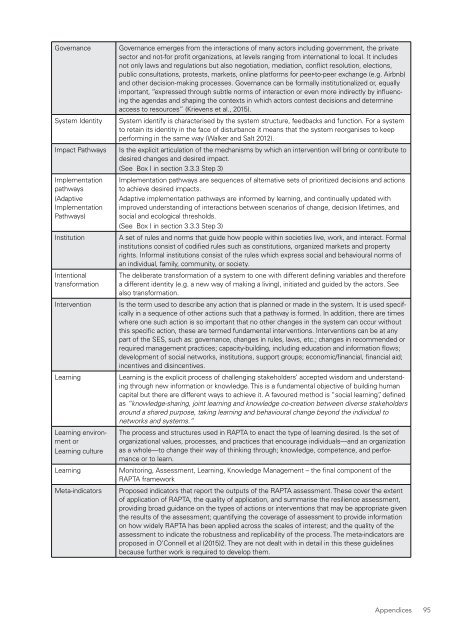DESIGNING PROJECTS IN A RAPIDLY CHANGING WORLD
srun3013fp1
srun3013fp1
Create successful ePaper yourself
Turn your PDF publications into a flip-book with our unique Google optimized e-Paper software.
Governance<br />
System Identity<br />
Impact Pathways<br />
Implementation<br />
pathways<br />
(Adaptive<br />
Implementation<br />
Pathways)<br />
Institution<br />
Intentional<br />
transformation<br />
Intervention<br />
Learning<br />
Learning environment<br />
or<br />
Learning culture<br />
Learning<br />
Meta-indicators<br />
Governance emerges from the interactions of many actors including government, the private<br />
sector and not-for profit organizations, at levels ranging from international to local. It includes<br />
not only laws and regulations but also negotiation, mediation, conflict resolution, elections,<br />
public consultations, protests, markets, online platforms for peer-to-peer exchange (e.g. Airbnb)<br />
and other decision-making processes. Governance can be formally institutionalized or, equally<br />
important, “expressed through subtle norms of interaction or even more indirectly by influencing<br />
the agendas and shaping the contexts in which actors contest decisions and determine<br />
access to resources” (Krievens et al., 2015).<br />
System identify is characterised by the system structure, feedbacks and function. For a system<br />
to retain its identity in the face of disturbance it means that the system reorganises to keep<br />
performing in the same way (Walker and Salt 2012).<br />
Is the explicit articulation of the mechanisms by which an intervention will bring or contribute to<br />
desired changes and desired impact.<br />
(See Box I in section 3.3.3 Step 3)<br />
Implementation pathways are sequences of alternative sets of prioritized decisions and actions<br />
to achieve desired impacts.<br />
Adaptive implementation pathways are informed by learning, and continually updated with<br />
improved understanding of interactions between scenarios of change, decision lifetimes, and<br />
social and ecological thresholds.<br />
(See Box I in section 3.3.3 Step 3)<br />
A set of rules and norms that guide how people within societies live, work, and interact. Formal<br />
institutions consist of codified rules such as constitutions, organized markets and property<br />
rights. Informal institutions consist of the rules which express social and behavioural norms of<br />
an individual, family, community, or society.<br />
The deliberate transformation of a system to one with different defining variables and therefore<br />
a different identity (e.g. a new way of making a living), initiated and guided by the actors. See<br />
also transformation.<br />
Is the term used to describe any action that is planned or made in the system. It is used specifically<br />
in a sequence of other actions such that a pathway is formed. In addition, there are times<br />
where one such action is so important that no other changes in the system can occur without<br />
this specific action, these are termed fundamental interventions. Interventions can be at any<br />
part of the SES, such as: governance, changes in rules, laws, etc.; changes in recommended or<br />
required management practices; capacity-building, including education and information flows;<br />
development of social networks, institutions, support groups; economic/financial, financial aid;<br />
incentives and disincentives.<br />
Learning is the explicit process of challenging stakeholders’ accepted wisdom and understanding<br />
through new information or knowledge. This is a fundamental objective of building human<br />
capital but there are different ways to achieve it. A favoured method is “social learning”, defined<br />
as “knowledge-sharing, joint learning and knowledge co-creation between diverse stakeholders<br />
around a shared purpose, taking learning and behavioural change beyond the individual to<br />
networks and systems.”<br />
The process and structures used in RAPTA to enact the type of learning desired. Is the set of<br />
organizational values, processes, and practices that encourage individuals—and an organization<br />
as a whole—to change their way of thinking through; knowledge, competence, and performance<br />
or to learn.<br />
Monitoring, Assessment, Learning, Knowledge Management – the final component of the<br />
RAPTA framework<br />
Proposed indicators that report the outputs of the RAPTA assessment. These cover the extent<br />
of application of RAPTA, the quality of application, and summarise the resilience assessment,<br />
providing broad guidance on the types of actions or interventions that may be appropriate given<br />
the results of the assessment; quantifying the coverage of assessment to provide information<br />
on how widely RAPTA has been applied across the scales of interest; and the quality of the<br />
assessment to indicate the robustness and replicability of the process. The meta-indicators are<br />
proposed in O’Connell et al (2015)2. They are not dealt with in detail in this these guidelines<br />
because further work is required to develop them.<br />
Appendices 95


